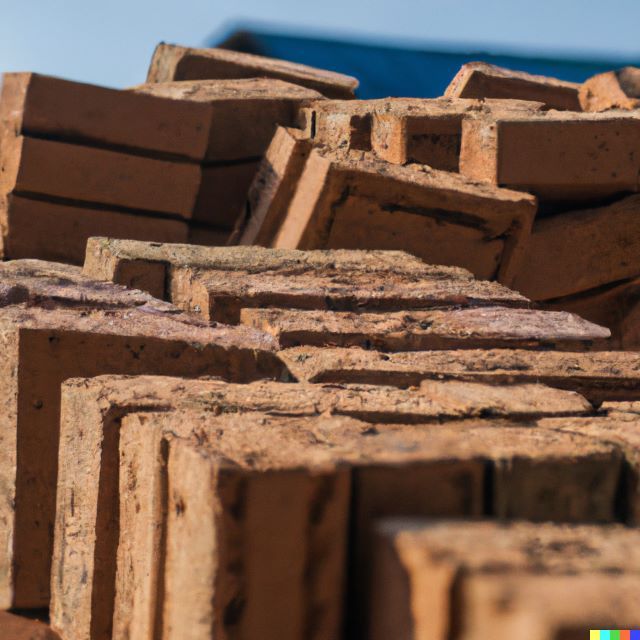Transforming Construction Waste into Sustainable Products
Learn how researchers are transforming Mexico's construction and demolition waste into useful and eco-friendly products. Their creative approach is helping to cut greenhouse gas emissions, save money on transportation, and make the construction industry more environmentally friendly as a whole.

Approximately 14,000 tons of construction and demolition waste are generated in Mexico City every day; of this amount, only 1,000 tons are recycled. In the meantime, Miguel Hidalgo alone makes 400,000 tons of trash every year; Alvaro Obregón makes more than a million tons; and Benito Juárez, for example, makes more than 200,000 tons.
This is a serious problem, said María Neftalí Rojas Valencia, a researcher at UNAM's Institute of Engineering (II). However, it is also an opportunity to use them as raw materials to elaborate useful products for new buildings.
The expert in environmental engineering said that because there are so many of them, they are often thrown away in bad ways or even in places that are against the law. Because of this, rivers, air, and soil become dirty, and harmful animals can grow and spread.
The current challenge for sustainable constructions that need certification from the Ministry of the Environment is to make them without waste, to use sustainable technologies and materials, to have good practices from the start of the project, and to use recyclable materials instead of traditional ones.
The scientist and her team have made different shapes and sizes of blocks or bricks out of construction waste and smaller leftovers from logging. They used mucilage, a sticky substance from the nopal cactus, instead of water and lime, which is a patented development.
Eco-Friendly Brick Production in Mexico: Combining Waste Materials and Solar Drying Techniques
In Mexico, the 17,000 artisan brick kilns manufacture 30 to 50 percent of national production; approximately 4,300 are located in Puebla, 2,500 in Jalisco, and 2,360 in Guanajuato. In several of these factories, employees work in precarious conditions since they make the mixtures with their hands and feet. In addition, 323 million units per year are obtained with high contamination rates.
"In other research that we have continued since 2015, we have made mixtures of construction waste with sawdust, waste from the sugar and paper industries, PET, glass, and cardboard, with good results," added Rojas Valencia.
The combinations are subjected to various tests, including erosion and weathering: ultraviolet rays and acid rain are simulated in a chamber to determine what happens to the new materials and even to project what will happen to them in the future.
"We are fortunate to have specialists and equipment at the Institute of Engineering where they help us test the bricks, such as compressive strength. "With all this, we cover what the regulations request in an efficient and controlled manner," said the university professor.
The bricks made with recycled aggregate work very well and have many benefits. For example, they reduce greenhouse gas emissions because they don't need to be fired. They also reduce the use of virgin material, cut down on transportation costs, and can be made in different sizes and shapes to meet different needs.
Another innovation that we have worked on, said Neftalí Rojas, is solar dryers to dry the bricks, but without causing greenhouse gases because firewood, tires, or oil are not used, as is the case with conventional production.
Innovations in Construction Waste Reuse: Solutions for Sustainable Development
The ones we made at the Institute were used to make flower pots and planters, as well as benches, sidewalks, and other urban furniture. In addition, Rojas said, with construction waste, sidewalks mixed with glass were placed; even after five years of hard work, they are still in perfect condition.
The use of construction debris can also be used to make land; "it is not necessary to crush, but rather to select the smallest fragments." They have also been used in synthetic soils.
"In Bordo Poniente, where there used to be a garbage dump, a bed of construction waste has been placed, then a bed of compost has been produced there, the soil has been added, and different vegetables have been successfully planted." "In the composting plant at University City, you can also see them; there they have worked in collaboration with the Institute of Geology," she argued.
With the fine aggregates from recycled concrete, the expert said, you can make walkways or bike paths. "We already have Ph.D. students in urban planning putting all the information together to work on urban parks based on the findings," she said.
At the II, samples of gabions have also been manufactured, which are used to avoid the possible fall of rocks and stones on the surfaces of roads and railroad tracks. Instead of breaking up the hill or using the rock on-site, we can take advantage of that large amount of waste.
Because even more waste is created in remodeling than in construction, viable alternatives are needed to reuse and recycle these materials, the researcher emphasized. They are usually mixed with the rest of the waste and contaminate it. "It is a hidden activity, without inventories."
These are fiberglass waste, some solvents, annealed and tempered glass, asbestos, fluorescent lamps with mercury and zinc, and paint and enamel residues containing heavy metals, among others. For a student's thesis work, we have taken advantage of those from Tablaroca and obtained finished products for interiors, for example. Civil Engineering and Architecture students are studying this aspect to propose other models.
Alexandra Ossa López, also a researcher at the II, made mixtures that can be used in asphalt layers for urban roads. Neftali Rojas says that this and other successful projects show that construction waste can be used in interiors and exteriors in both cities and rural areas.
"Students of civil engineering, urban planning, architecture, and even chemistry are on the team because we need to describe our mixtures," she said in the end.




